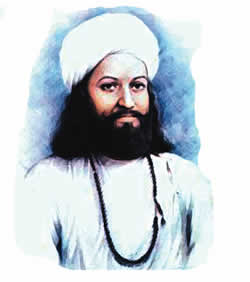Celebrating the poet of love
By Ali Usman
Daily Times: July 26, 2007
 LAHORE: Jandiala Sher Khan, a small town on Hafizabad Road, some 14 kilometres away from Sheikhupura gets over-packed from July 23 to 25 every year when people from all over Punjab visit the town to pay tribute to one of the greatest Sufi poets of Punjab, Waris Shah. LAHORE: Jandiala Sher Khan, a small town on Hafizabad Road, some 14 kilometres away from Sheikhupura gets over-packed from July 23 to 25 every year when people from all over Punjab visit the town to pay tribute to one of the greatest Sufi poets of Punjab, Waris Shah.
The town is the birthplace of Shah, called by many as the saint of love and tolerance. Shah was the most prominent Punjabi poet of the 18th century. He was born in the house of Syed Gul Sher in 1722 and died in 1798 in the same village. He got his early education in a mosque in Jandiala Sher Khan. The mosque still exists to the northwest of the tomb.
The poet completed his formal education of Dars-e-Nizami in Kasur by Molvi Ghulam Murtaza Kasuri. Bullay Shah (another great Punjabi poet) had also been a student of the same seminary. Later, for spiritual training, Waris Shah went to Pakpattan at the shrine of Baba Fareed. He later became Imam in a mosque at Malika Hans. Heer, a romantic folk tale, is considered Waris Shah’s masterpiece.
In the three-day fair of Shah’s urs, various events take place including kabaddi matches, horse dances, Punjabi poetry sessions, dramas of Heer Ranjha and many folk dances.
Ibrahim, a 70-year devotee, who had come to the fair from Shah Kot told Daily Times that the fair was a gathering of those who were against ‘stick-wielding Islam’ and ‘hardcore’ mullahs. He said he had visited the shrine for many years and participation in the fair gave him spiritual peace. He said he was illiterate but his love for Sufism had taught him to say verses. He said he loved participating in the poetry competition held at the festival. “Waris Shah’s teachings are for lovers. Those who do not believe in love cannot benefit from the shrine”, he said. He said Waris Shah was a great inspiration for those who believed in love.
Like in other years, this year, a Punjabi poetry competition (Mushiara) was held on the first day of the urs in which winners were awarded cash prizes. Competitions of flute playing and kabaddi were also held on the first day. The final competition and a special programme of reciting folk tales was held on Wednesday.
Bibi Hajan, a devotee from Gujranwala, said Shah was a saint and the wishes of those who visited his shrine were fulfilled. She said there was a tradition at the shrine of tying strings and making a wish. “Those who do not have doubt and malice in their hearts come to open the strings and distribute langar (free food) among the devotees”. She said she believed that Waris Shah was a mystic who kept the spark of love alight in people’s heart.
Amjad Ali Zaragar, a Lahori dervish said he attended the fair every year along with his followers. He said the place was a refuge for those who had to face criticism for falling in love. He pointed out a tree saying, “Two and a half leaves of that tree are enough to cure depression and other such mental conflicts”. He said many people lighted lamps at the shrine as a token of affection for ‘the saint of love and tolerance’.
Khariyaat Ali Shah, a descendent of Waris Shah, said the government had driven him and his family off the shrine many years ago. He said the Auqaf Department did not give him anything out of the shrine’s income. He said the government had also changed the dates of the festival from 8, 9, 10 of the seasonal month, Sawan, to 7, 8, 9 of Sawan. Sheikhupura Executive District Officer Imtiaz Malik said that about 100,000 devotees visited the shrine everyday during the urs. He said that this number jumped further on the festival’s last day. He said the government had set up a medical camp near the shrine to facilitate sick people attending the fair.
Many people set up stalls at the urs every year, making the event more colourful. The items on the stalls range from pottery to eatables. The Lucky Irani Circus has also put up its shows to entertain the devotees.
|
![]()